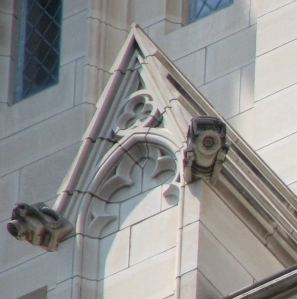It has long been a tradition among stonemasons to use contemporary motifs and symbols when carving ornamental details of Gothic cathedrals. Virtually the only form of sculpture where a great deal of creative freedom (and fun) was allowed, gargoyles and grotesques are a fascinating window into a medieval craftsman’s imagination. Exotic animals, chimeras, monsters, disfigured bodies, contorted faces – these are some of the most vivid images of the era, rivaled only by the similarily-themed bestiaries and mappae mundi.
We are so used to these playful statues, that we hardly ever notice how out of place they are. And yet no one really knows how they started or what they represent. Even the contemporaries were baffled; the earliest known piece of writing about gargoyles is by Saint Bernard in the 12th century, and he is as puzzled as we are: “What are these fantastic creatures? What is the meaning of these unclean monkeys, these strange savage lions and monsters?” Hear, hear!
Probably the easiest way to understand the intended effect of these grotesque figures is to visualize what kind of bizarre curiosities would a modern carver choose to shock or amuse the public. Lucky for us, we don’t have to imagine anything; the tradition never died out, and there are some striking examples produced in the 20th and 21st centuries.
Washington National Cathedral is a fine neogothic church, built from 1907 to 1990 and covered in hundreds of grotesques. For a very traditional-looking building, these are a very unexpected bunch. The most famous one is the head of, wait for it, Darth Vader:[1]
The Dark Lord is accompanied, among others, by a man with a movie camera, a candid cameraman (Jonah-style), a pacifist and a high-tech pair:


The New Cathedral of Salamanca was constructed between the 16th and 18th centuries in late Gothic and Baroque styles. During the 1992 restoration of its lavishly decorated façade a new element was added, an astronaut entangled in a cable-like ornamental vine:[2]
St. George’s Chapel at Windsor Castle was founded by Edward III in 1348 and has been the site of many royal wedding, funerals and interments ever since. One of the England’s most important churches, it has been renovated countless time. The most recent restoration project took place in the last ten years. In 2010, several new grotesques were ordered to replace weathered ones. Arguably, the most interesting work was created by Tom Brown. He based the carving on the famous earmouse, Charles Vacanti’s experiment involving grafting of an ear-shaped cartilage onto a laboratory mouse:
In all these cases artists needed a symbolic representation of what is strange, unsettling or frightening about our time. I find it very telling and poignant that they all looked towards science and technology.
References:







